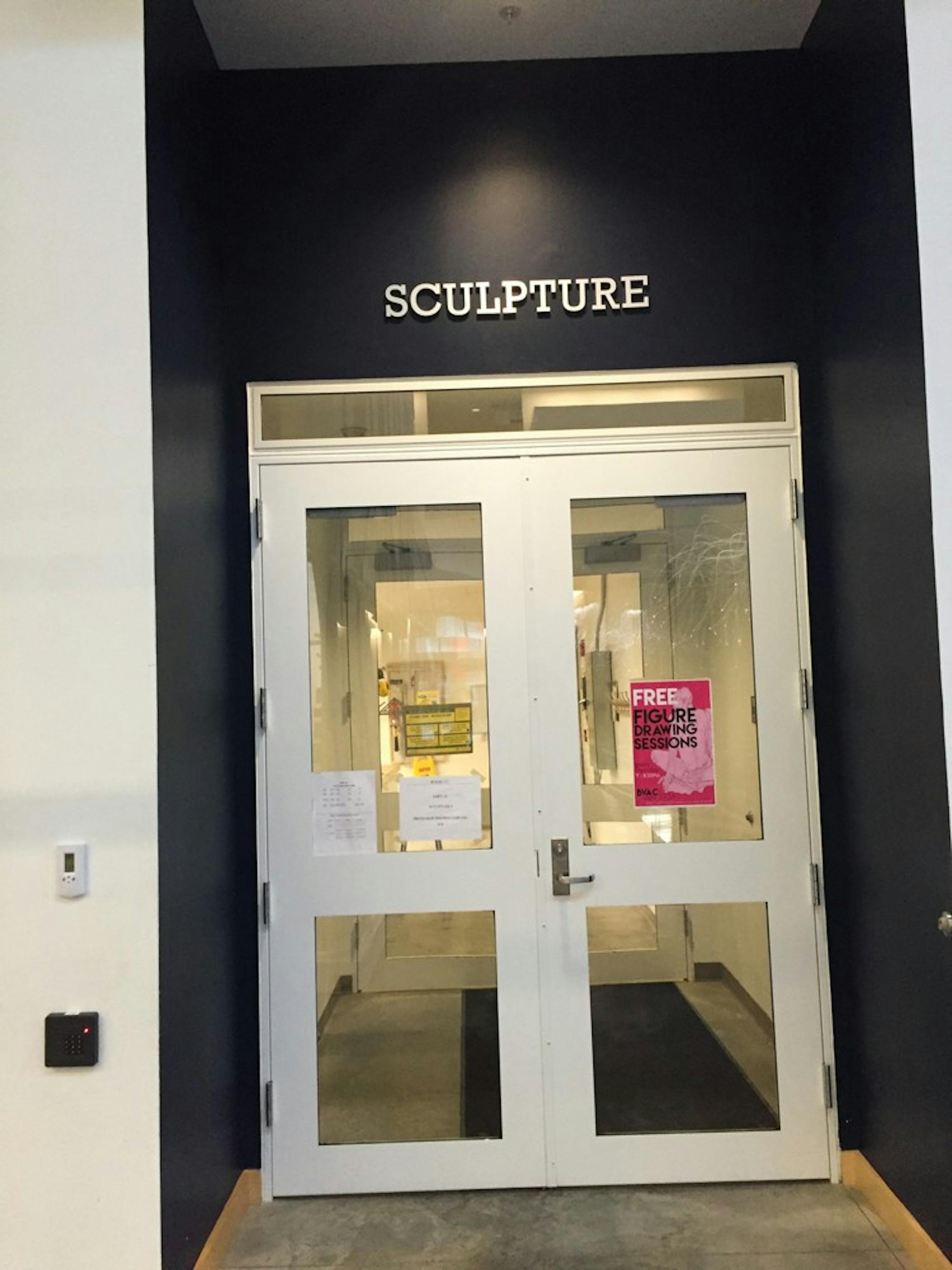[slideshow_deploy id='121035']
In the sculpture studios on the first floor of the Black Family Visual Arts Center, students’ erratic, twisting sculptures line the room’s perimeter like suspended dreams. Anatomical skeletons patiently wait to inspire and guide the next class. A huge sculpted hand emerges from a table nearby, outspread as if in expectation, and across the room a life-size cardboard figurine is splayed face first on a table in a sadly relatable facsimilie of a student passed out while studying. Long yellow cables dangle from the ceiling, and an array of equipment, tools and materials hang on the wall like a creative’s arsenal. An adjoining room contains heavy soldering equipment, another room has rows of plaster molds and industrial air vents, and yet another is stocked with glistening saws and woodworking equipment. In the multiple rooms of the sculpting studio, students from all backgrounds and majors explore their creative side.
The studio art department offers sculpture courses every semester, for students of all experience levels and backgrounds interested in exploring sculpture and the abundant resources the department boasts. The courses include “Sculpture I,” available every semester, which introduces multiple forms of sculpture, including clay, plaster, wood, cardboard, wire, recycled materials and more for those looking for a new experience and instruction. The department also offers upper-level sculpture courses for students to further advance their skills.
Sculpture students rarely want for materials or equipment. From the very first project for “Sculpture I,” the department supplies everything the students could need.
“They had a plethora of things to use,” said Emma Mouzon ’18, a former “Sculpture I” student. “Boxes of bamboo sticks. All the supplies were there. Everything.”
Students also have exclusive, around-the-clock access to the stocked, modernist facilities, and the autonomy to work on their projects whenever creativity, or free time, is flowing. Students have access to a woodshop, a molding room, two sculpture spaces, a metal shop and more.
“It’s so different from every other class at Dartmouth that I’ve taken,” studio art intern and sculpture teaching assistant Malika Khurana ’15 said. “It’s something where you have to learn to be self-reliant and make decisions on your own and manage your own materials. There’s nobody who’s going to tell you how to do it, because it’s about you.”
All these options exist in a cooperative, encouraging environment unlike the competitive conditions sometimes prevalent in Dartmouth courses. Khurana commented that students develop stronger relationships with their professors and that makes the studio art community feel like a family.
“I’ve had classes that get really close, you’re all sort of vibing together at the same time,” Khurana said. “It has a real community feel, in this building.”
Whether the moment requires a helping hand, constructive reflection and feedback or technical input from the professor and class TA, assistance is never far away.
“It was very collaborative in the sense of getting opinions on your work or needing help,” Mouzon said.
This comfortable environment can pacify the uncertainties that sometimes plague new artists.
“It’s not that you have to talk about it personally, but art is something that becomes so tied to who you are,” Khurana said. “So a lot of it is being very vulnerable, and facing things that you are insecure about.”
Trained for rigid rubrics and demanding expectations, students sometimes struggle at first with the program’s flexibility and indeterminacy. But with experience, they often build trust in their creative impulses as professors instruct them on new tools, techniques and materials.
“There’s also no right answer. Students in the lower level classes will often talk about what the professor wants. But that’s so irrelevant,” Khurana said. “In that sense, it’s a very pure form of education.”
This manifests in an individuality between projects obvious to even a cursory survey of the many strewn across the sculpture spaces.
“Everybody has their own ideas and they’re not meant to look the same, because everybody is an individual,” studio art professor Brenda Garand said.
For former students like Khurana and Mouzon, it is not difficult to see how creative flourishing can add to a Dartmouth experience, and foster the area of talents that can wither under relentless exams and requirements. For Mouzon, who is also an economics major, this artistic exposure was a chance to regenerate her creative drive.
“I love it. Because there’s definitely a part of myself that’s very organized and structured,” Mouzon said. “But there’s definitely another part that’s extremely enthusiastic and creative.”
Since the department is so open, sculpture classes draw together students of different stripes. Khurana, who also double majored in engineering, reflected on the intermingling of interests and talents.
“It’s been funny in my own experience, because I never came to Dartmouth thinking I would do studio art,” Khurana said. “Everything is so interdisciplinary. Computer Science majors end up loving art classes.”
In the eyes of Khurana, this fulfills the promise of a liberal arts education, since very few impediments exist to prevent students from across the board from dabbling in an art class.
“It’s very inspiring to see that you can do both, and [kind of] have the left brain, right brain going together, and intersperse them together,” Mouzon said.
Garand said that she hopes that her students leave with a changed perspective that might be hard to achieve elsewhere.
“I think that the main thing is that it will change how they view the world and see the world, every day and moving through spaces,” Garand said. “Looking at spaces, thinking about forms, thinking about ideas.”
For those on the fence about dabbling in sculpture, Mouzon effusively recommends the experience.
“I would say don’t be scared to explore a side of yourself that you might have denied,” Mouzon said. “You learn a lot as you go and you realize you are capable of so much.”




